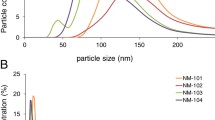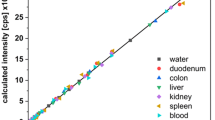Abstract
Ammonium citratoperoxotitanate IV (TAS-FINE) is a water-soluble titanium complex used to synthesize a photocatalytic titanium(IV) oxide film. This study was aimed to investigate the LD50, dose-response, time-course response, and renal toxicity of TAS-FINE using an animal model. Serum titanium (S-Ti) and its 24-h urinary excretion (U-Ti) were determined by inductively coupled plasma-argon emission spectrometry (ICP-AES) after a single oral TAS-FINE administration to male Wistar rats. The LD50 of TAS-FINE was 7.97 g/kg body weight in 24 h, and its half-life was 3.78±1.28 d for S-Ti and 2.19±0.09 d for U-Ti. Although TAS-FINE was not easily absorbed in the gastrointestinal tract, it was distributed into the bloodstream in a dose-dependent manner. Within 24 h, 0.189% of administrated Ti was excreted via urine. It was speculated that TAS-FINE formed conjugates with serum constituents that resulted in nephrotoxicity resulting from an allergic reaction. The observed indices in this study were revealed to be good indicators for TAS-FINE exposure. The analytical method and animal model described in this study will help to further elucidate details about human exposure to TAS-FINE, which in recent times has become an occupational and environmental toxicant of concern.
Similar content being viewed by others
References
M. Kakihana, K. Tomita, V. Petrykin, M. Tada, S. Sasaki, and Y. Nakamura, Chelating of titanium by lactic acid in the water-soluble diammonium tris (2-hydroxypropionato) titanate(IV), Inorg. Chem. 43, 4546–4548 (2004).
O. A. Kholdeeva, T. A. Trubitsina, R. I. Maksimovskaya, et al., First isolated active titanium peroxo complex: characterization and theoretical study. Inorg. Chem. 43, 2284–2292 (2004).
O. A. Kholdeeva, G. M. Maksimov, R. I. Maksimovskaya, et al., A dimeric titanium-containing polyoxometalate. Synthesis, characterization, and catalysis of H2O2-based thioether oxidation, Inorg. Chem. 39, 3828–3837 (2000).
J. S. Dalton, P. A. Janes, N. G. Jones, J. A. Nicholson, K. R. Hallam, G. C. Allen, Photocatalytic oxidation of NOx gases using TiO2: a surface spectroscopic approach, Environ. Pollut. 120, 415–422 (2002).
S. B. Kim, H. T. Hwang, S. C. Hong. Photocatalytic degradation of volatile organic compounds at the gas-solid interface of a TiO2 photocatalyst, Chemosphere 48, 437–444 (2002).
W. Wang, L. W. Chiang, and Y. Ku, Decomposition of benzene in air streams by UV/TiO(2) process, J. Hazard Mater. 101, 133–146 (2003).
A. Harstrick, H. J. Schmoll, G. Sass, H. Poliwoda, and T. Rustum, Titanocendichloride activity in cisplatin and doxorubicin-resistant human ovarian carcinoma cell lines, Eur. J. Cancer 29, 1000–1002 (1993).
F. Caruso and M. Rossi, Antitumor titanium compounds, Mini. Rev. Med. Chem. 4, 49–60 (2004).
E. Melendez, Titanium complexes in cancer treatment, Crit. Rev. Oncol. Hematol. 42, 309–315 (2002).
A. Korfel, M. E. Scheulen, H. J. Schmoll et al., Phase I clinical and pharmacokinetic study of titanocene dichloride in adults with advanced solid tumors, Clin. Cancer Res. 4, 2701–2708 (1998).
G. Lummen, H. Sperling, H. Luboldt, T. Otto, and H. Rubben, Phase II trial of titanocene dichloride in advanced renal-cell carcinoma, Cancer Chemother. Pharmacol. 42, 415–417 (1998).
K. Mross, P. Robben-Bathe, L. Edler, et al., Phase I clinical trial of a day-1, −3, −5 every 3 weeks schedule with titanocene dichloride (MKT 5) in patients with advanced cancer. (Phase I Study Group of the AIO of the German Cancer Society), Onkologie 23, 576–579 (2000).
L. G. Harris and R. G. Richards, Staphylococcus aureus adhesion to different treated titanium surfaces, J. Mater. Sci. Mater. Med. 15, 311–314 (2004).
J. Parvizi, E. Wickstrom, A. R. Zeiger, et al.., Titanium surface with biologic activity against infection, Clin. Orthop. Related Res. 429, 33–38 (2004).
K. P. Kuhn, I. F. Chaberny, K. Massholder, et al., Disinfection of surfaces by photocatalytic oxidation with titanium dioside and UVA light, Chemosphere 53, 71–77 (2003).
B. S. Richards, S. F. Rowlands, A. Ueranatasun, J. E. Cotter, and C. B. Honsberg, Potential cost reduction of buried-contact solar cells through the use of titanium dioxide thin films, Solar Energy 76, 269–276 (2004).
M. Niemela, P. Peramaki, and J. Piispanen, Microwave sample-digestion procedure for determination of arsenic in moss samples using electrothermal atomic absorption spectrometry and inductively coupled plasma mass spectrometry, Anal. Bioanal. Chem. 375, 673–678 (2003).
A. Sahuquillo, R. Rubio, J. M. Ribo, E. Ros, and M. Vela, Application of focused-microwave wet digestion to the determination of trace metals in human gallstones by ICP/AES, J. Trace Elements Med. Biol. 14, 96–99 (2000).
M. Krachler, H. Radner, and K. J. Irgolic, Microwave digestion methods for the determination of trace elements in brain and liver samples by inductively coupled plasma mass spectrometry, Anal. Bioanal. Chem. 355, 120–128 (1996).
I. A. Bergdahl, A. Schutz, L. Gerhardsson, A. Jensen, and S. Skerfving, Lead concentrations in human plasma, urine and whole blood, Scand. J. Work Environ. Health 23, 359–363 (1997).
Z. Karpas, L. Halicz, J. Roiz, et al., Inductively coupled plasma mass spectrometry as a simple, rapid, and inexpensive method for determination of uranium in urine and fresh water: comparison with LIF, Health Phys. 71, 879–885 (1996).
P. Allain, Y. Mauras, C. Douge, L. Jaunault, T. Delaporte, and C. Beaugrand, Determination of iodine and bromine in plasma and urine by inductively coupled plasma mass spectrometry, Analyst 115, 813–815 (1990).
J. Edel, E. Marafante, and E. Sabbioni, Retention and tissue binding of titanium in the rat, Hum. Toxicol. 4, 177–185 (1985).
L. Messori, P. Orioli, V. Banholzer, I. Pais, and P. Zatta, Formation of titanium (IV) transferrin by reaction of human serum apotransferrin with titanium complexes, FEBS Lett. 442, 157–161 (1999).
S. Artik, K. Haarhuis, X. Wu, J. Begerow, and E. Gleichmann, Tolerance to nickel: oral nickel administration induces a high frequency of aneregic T cells with persistent suppressor activity, J. Immunol. 167, 6794–6803 (2001).
S. G. Adler, A. H. Cohen, and R. J. Glassock, Secondary glomerular diseases, in The Kidney, B. M. Brenner, et al., eds., WB Saunders, Philadelphia, pp. 1498–1596 (1996).
P. Boffetta, V. Gaborieau, L. Nadon, M. F. Parent, E. Weiderpass, and J. Siemiatycki, Exposure to titanium dioxide and risk of lung cancer in a population-based study from Montreal Scand. J. Work. Environ. Health 27, 227–232 (2001).
P. Boffetta, A. Soutar, J. W. Cherrie, et al., Mortality among workers employed in the titanium dioxide production industry in Europe, Cancer Causes Control 15, 697–706 (2004).
J. P. Fryzek, B. Chadda, D. Marano, et al., A cohort mortality study among titanium dioxide manufacturing workers in the United States, J. Occup. Environ. Med. 45, 400–409 (2003).
S. M. Paulsen, L. B. Nanney, J. B. Lynch, Titanium tetrachloride: an unusual agent with the potential to crate severe burns, J. Burn Care Rehabil. 19, 377–381 (1998).
D. K. Chitkara and B. J. McNeela, Titanium tetrachloride burns to the eye, Br. J. Ophthalmol. 76, 380–382 (1992).
T. Park, R. DiBenedetto, K. Morgan, R. Colmers, and E. Sherman, Diffuse endobronchial polyposis following a titanium tetrachloride inhalation injury, Am. Rev. Respir. Dis. 130, 315–317 (1984).
Author information
Authors and Affiliations
Rights and permissions
About this article
Cite this article
Nakasuji, K., Usada, K., Kawasaki, T. et al. Urinary and serum titanium. Biol Trace Elem Res 110, 119–131 (2006). https://doi.org/10.1385/BTER:110:2:119
Received:
Accepted:
Issue Date:
DOI: https://doi.org/10.1385/BTER:110:2:119




